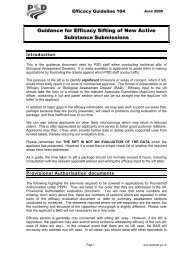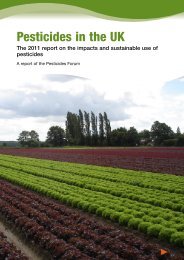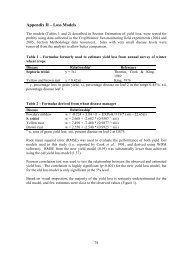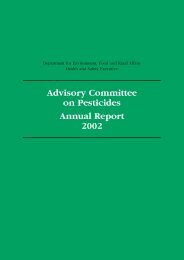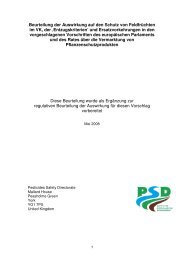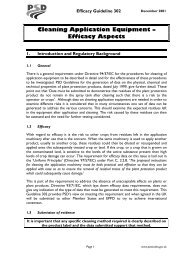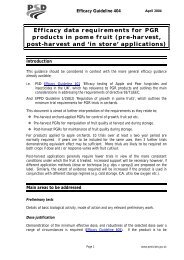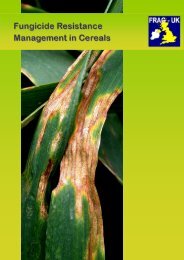Advisory Committee on Pesticides Annual Report 2001
ACP Annual Report 2001 - Pesticides Safety Directorate
ACP Annual Report 2001 - Pesticides Safety Directorate
You also want an ePaper? Increase the reach of your titles
YUMPU automatically turns print PDFs into web optimized ePapers that Google loves.
<str<strong>on</strong>g>Advisory</str<strong>on</strong>g> <str<strong>on</strong>g>Committee</str<strong>on</strong>g> <strong>on</strong> <strong>Pesticides</strong> <strong>Annual</strong> <strong>Report</strong> <strong>2001</strong><br />
Following the Court judgement, approval holders for both agricultural and<br />
n<strong>on</strong>-agricultural products were asked to provide any further data relating to<br />
the potential genotoxic carcinogenicity of dichlorvos. These data would be<br />
c<strong>on</strong>sidered by the ACP early in 2002.<br />
Diur<strong>on</strong><br />
The ACP c<strong>on</strong>sidered submissi<strong>on</strong>s received from four companies c<strong>on</strong>cerned<br />
with antifouling products c<strong>on</strong>taining diur<strong>on</strong>. The <str<strong>on</strong>g>Committee</str<strong>on</strong>g> had c<strong>on</strong>sidered<br />
the use of this compound in antifouling products in September 2000. Members<br />
had c<strong>on</strong>sidered that the safety margins for professi<strong>on</strong>al and amateur users of<br />
products were not as high as they would wish and that use of these products<br />
posed an unacceptable risk to the aquatic envir<strong>on</strong>ment. Therefore the ACP<br />
had recommended that all uses of diur<strong>on</strong> in antifouling products should be<br />
revoked. The companies resp<strong>on</strong>ding now expressed c<strong>on</strong>cern that acti<strong>on</strong> taken<br />
<strong>on</strong>ly in the UK would be a barrier to trade and put them at a competitive<br />
disadvantage and asked for an extended phase-out period for products, to<br />
enable alternatives to be developed.<br />
60<br />
The <str<strong>on</strong>g>Committee</str<strong>on</strong>g> c<strong>on</strong>sidered that companies had been provided with adequate<br />
informati<strong>on</strong> regarding the possibility of revocati<strong>on</strong>. Few had submitted<br />
comments to the <str<strong>on</strong>g>Committee</str<strong>on</strong>g> and it c<strong>on</strong>cluded that the submissi<strong>on</strong>s made were<br />
not sufficient to justify cancellati<strong>on</strong> of, or changes to the timescales for, the<br />
revocati<strong>on</strong>s agreed previously.<br />
Fenitrothi<strong>on</strong><br />
Fenitrothi<strong>on</strong> is an organophosphorus compound currently approved for n<strong>on</strong>agricultural<br />
use as an insecticide against crawling and flying insects. It is <strong>on</strong>e<br />
of the chemicals included in the current review of organophosphorus and<br />
carbamate compounds. Currently, n<strong>on</strong>-agricultural pesticide products<br />
c<strong>on</strong>taining fenitrothi<strong>on</strong> are approved for both professi<strong>on</strong>al and amateur use,<br />
with amateur use restricted to aerosol space and surface sprays. Professi<strong>on</strong>al<br />
use encompasses emulsifiable and microencapsulated c<strong>on</strong>centrates, wettable<br />
and dusting powders approved for use as public hygiene insecticides and<br />
animal husbandry insecticides. The <str<strong>on</strong>g>Committee</str<strong>on</strong>g> c<strong>on</strong>sidered a review of the<br />
physical chemistry, mammalian toxicity and efficacy of fenitrothi<strong>on</strong>.<br />
The main health effect of c<strong>on</strong>cern for fenitrothi<strong>on</strong> was its anticholinesterase<br />
activity. However, the review also identified a number of other health effects<br />
that the <str<strong>on</strong>g>Committee</str<strong>on</strong>g> needed to c<strong>on</strong>sider. The evidence presented dem<strong>on</strong>strated<br />
that acute pois<strong>on</strong>ing with fenitrothi<strong>on</strong> caused Intermediate Syndrome (IMS).




